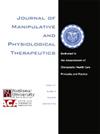Effect of Chiropractic Intervention on Oculomotor and Attentional Visual Outcomes in Young Adults With Long-Term Mild Traumatic Brain Injury: A Randomized Controlled Trial
IF 1.4
4区 医学
Q4 HEALTH CARE SCIENCES & SERVICES
Journal of Manipulative and Physiological Therapeutics
Pub Date : 2024-01-01
DOI:10.1016/j.jmpt.2024.08.003
引用次数: 0
Abstract
Objective
This study aimed to establish if chiropractic care can improve oculomotor and cognitive symptoms in individuals with persistent postconcussion syndrome (PPCS).
Methods
A single-blind, randomized controlled intervention study recorded baseline computerized eye-tracker assessment (CEA) outcomes in 40 young adults with PPCS following mild traumatic brain injury. Participants were randomly allocated to either a chiropractic or age-matched active control intervention, and the change in CEA outcomes following intervention was compared between the chiropractic and control groups. A battery of CEAs including egocentric localization, fixation stability, pursuit, saccades, Stroop, and the vestibulo-ocular reflex, were used to assess oculomotor function, visual attention/processing, and selective attention.
Results
Relative to the control group, participants receiving the chiropractic intervention scored better in the Stroop test (P < .001), had improved gaze stability during both vestibulo-ocular reflex (P < .001) and fixation stability (P = .009), and a lower vertical error in egocentric localization (P < .001). However, performance was poorer in pursuits, where they had an increased tracking error (P < .001).
Conclusion
Chiropractic care in participants with PPCS significantly improved static and dynamic gaze stability, and performance in the Stroop test, compared with a control intervention. These results suggest that chiropractic care can offer a novel avenue for alleviating certain visual and cognitive symptoms in patients with PPCS. It also adds to the growing evidence that suggests that some longstanding PPCS visual symptoms may have a spinal or proprioceptive basis.
脊骨神经科干预对长期轻度脑外伤青少年眼球运动和视觉注意力结果的影响:随机对照试验》。
研究目的本研究旨在确定脊骨神经治疗能否改善持续性脑震荡后综合征(PPCS)患者的眼球运动和认知症状:这项单盲随机对照干预研究记录了40名轻度脑外伤后患有持续性脑震荡后综合征(PPCS)的年轻人的基线电脑眼动仪评估(CEA)结果。参与者被随机分配到脊骨神经治疗组或年龄匹配的积极对照组,并比较脊骨神经治疗组和对照组在干预后CEA结果的变化。一系列CEA包括眼球中心定位、固定稳定性、追逐、囊视、Stroop和前庭眼反射,用于评估眼球运动功能、视觉注意力/处理和选择性注意力:与对照组相比,接受脊椎按摩干预的参与者在Stroop测试中得分更高(P < .001),前庭眼反射时的注视稳定性(P < .001)和固定稳定性(P = .009)均有所改善,自我中心定位的垂直误差更小(P < .001)。然而,他们在追逐中的表现较差,跟踪误差增加(P < .001):结论:与对照组干预相比,脊骨神经科治疗可明显改善PPCS患者的静态和动态注视稳定性,以及Stroop测试成绩。这些结果表明,脊骨神经治疗可为缓解PPCS患者的某些视觉和认知症状提供一条新途径。此外,越来越多的证据表明,一些长期存在的多发性硬化症视觉症状可能与脊柱或本体感觉有关。
本文章由计算机程序翻译,如有差异,请以英文原文为准。
求助全文
约1分钟内获得全文
求助全文
来源期刊
CiteScore
3.00
自引率
7.70%
发文量
63
审稿时长
29 weeks
期刊介绍:
The Journal of Manipulative and Physiological Therapeutics (JMPT) is an international and interdisciplinary journal dedicated to the advancement of conservative health care principles and practices. The JMPT is the premier biomedical publication in the chiropractic profession and publishes peer reviewed, research articles and the Journal''s editorial board includes leading researchers from around the world.
The Journal publishes original primary research and review articles of the highest quality in relevant topic areas. The JMPT addresses practitioners and researchers needs by adding to their clinical and basic science knowledge and by informing them about relevant issues that influence health care practices.

 求助内容:
求助内容: 应助结果提醒方式:
应助结果提醒方式:


